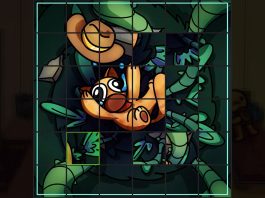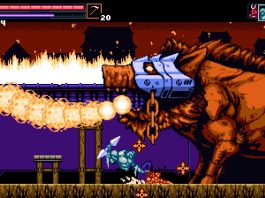Taimumari is a retro platform-styled game, first released way back in December 2015 for the PC. Being developed by TERNOX, Taimumari is an attempt to recapture the feel and style of the early platformers. Starring an apprentice sorceress called Himari, it garnered largely positive feedback and reviews on its original release. A kind of follow up – Legend of Himari – was also released, and now both games are gathered under one banner as Taimumari: Complete Edition on Xbox One. So, does the Xbox need another retro platformer, and does Taimumari bring anything new (or indeed old) to the table?

First impressions are “Wow, that’s retro!”. From the chiptune music, instantly flashing back to the NES and the myriad of platformers on that console, to the way the characters look, all cute and cuddly, despite having raggedy edges, anyone spending time with this will immediately feel at home. One note though – the music volume seems to be just short of ear-bleeding, so a quick dive into the options to turn it down will be your first stop. You know what you don’t find in the options, however? A difficulty setting. You’ll play this game the way it was meant to be played.
So, with the graphics and tunes wrapped in a rose-tinted duvet of nostalgia, it’s best to start with the first game, Taimumari. The plot is largely unintelligible, involving magic, time, and a floating sky country called Zaria. Now, due to a magic crystal, the citizens of Zaria existed largely outside of time, but due to evil forces breaking the crystal this existence is under threat. This is where you come in, as Himari. For some reason, all the qualified wizards can’t go and get the crystal back together so Himari, despite not being qualified in the slightest, is told that she is the chosen one and has to go forth and save the day. What this translates into is a chase across time to bring four miscreants to justice, and once they are defeated then, and only then, will the shadowy figure behind the scenes be able to be dealt with. The main baddy looks a lot like the Joker in cutscenes, the same green hair and enormous smile that doesn’t look right, and despite besting him at the end of the first stage you can’t actually defeat him until his minions have been brought to heel.
As you’d expect for a game of this type, each one of his minions has a world all of their own, where they make the rules. Any of the four worlds can be chosen right from the start, and it’s up to you to pick the best course through them. Each world that you complete, and boss that you defeat, gives you an added dimension to use in the game: for example beating Fallenstar – the Knight boss in his castle world – will give you a magic shield, which will come in handy in the second world, so it may pay to do that world first. Also, as you would expect each world is a little different from the others, and obviously this includes the obligatory difficult ice world that all platformers must contain by law. Combining low friction surfaces with pinpoint jumping makes for a pad-bitingly frustrating level, but it’s doable with a bit of luck and the reflexes of a ninja hopped up on Monster.

So far, so Megaman, you might be thinking, and to be fair the comparison is a justified one. Getting through worlds designed to strip you of lives, beating bosses to claim new powers, and having some insanely difficult sections where the difficulty seems to be turned up to 11, are all features of Taimumari. There’s not even just platforming on offer here: in one of the levels, Himari finds that she can fly (only in this level, mind) and as such the midsection of the stage turns into a side-scrolling shoot ’em up. While this is a nice distraction, it’s also a bit jarring the first time you enter the level with no warning.
As a whole though, beating Taimumari is a tricky affair, yet the spur of limited lives, the no continues, and some seriously stripped-back gameplay is quite compelling. You can usually put your finger on where you went wrong, and exactly where you tried to take liberty with a game that takes no prisoners.
The other game in the bundle, Legend of Himari, is an altogether different proposition and, at risk of minor spoilers, not in a good way. The game has you, as Himari, positioned in the middle of the screen, and you don’t move. Enemies run in from the left and right, and you are tasked to press the X and B buttons to attack on either side. That’s it. Imagine One Finger Death Punch with cute 8-bit characters and some slightly dodgy hit detection, and you’re close. The thing is, while you are busy looking left and right, you also have to use the right stick to steer a hand icon around the screen, either to collect weapons or to use magic to shoot flying enemies coming in from above. This just doesn’t work for me at all, as it seems to be nigh on impossible to attack left, right and above simultaneously; like trying to rub your stomach and pat your head while taking your driving test. It is possibly achievable, but it’s not a good idea. And that’s how I felt about the Legend of Himari segment of this game sadly; it just isn’t any fun to play.

In conclusion and Taimumari: Complete Edition on Xbox One is very much a game of two halves. Taimumari itself is an enjoyable retro platform romp from the era where gameplay outweighed graphics, and it is still a great deal of fun to play to this day. The Legend of Himari, on the other hand, tries to do something different and sadly fails, creating a game that isn’t fun, instead causing frustration.
Play one, ignore the other, and you’ll have a much better time, I promise.







